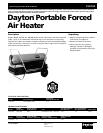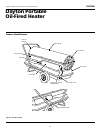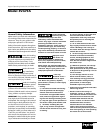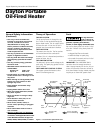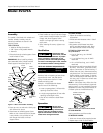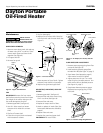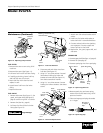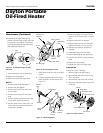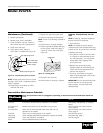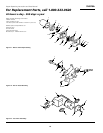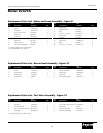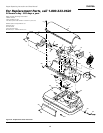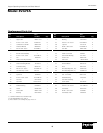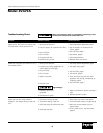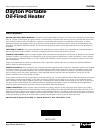
Dayton Operating Instructions and Parts Manual
3
Model 3VG79A
Version B - For Reduction G016.J
®
General Safety Information
Make certain you read and understand
all warnings. Keep these instructions for
reference. They are your guide to safe
and proper operation of this heater.
Safety information appears throughout
these instructions. Pay close attention to
them. Below are definitions for the safety
information listed throughout this manual.
Under this heading,
installation, operat-
ing, and maintenance procedures or
practices will be found that, if not
carefully followed, WILL result in IMME-
DIATE serious personal injury or death.
Under this head-
ing, installation,
operating, and maintenance proce-
dures or practices will be found that, if
not carefully followed, COULD result in
severe personal injury or death.
Under this heading,
installation, operat-
ing, and maintenance procedures or
practices will be found that, if not carefully
followed, COULD result in minor personal
injury, product or property damage.
IMPORTANT: Every possible circumstance
that might involve a hazard cannot be
anticipated. The warnings in this manual
and on tags or decals affixed to the unit
are therefore not all-inclusive. If a
procedure, work method, or operating
technique not specifically recommended
by Dayton is used, you must make sure it
is safe for you and others. You should
also ensure that equipment will not be
damaged or made unsafe by the operat-
ing or maintenance method you choose.
Carbon monoxide
poisoning may lead
to death! Some people are more
affected by carbon monoxide than
others. Early signs of carbon monoxide
poisoning resemble the flu, with
headaches, dizziness, and/or nausea. If
you have these signs, the heater may
not be operating properly, or the areas
may not be sufficiently ventilated. Get
fresh air at once! Have heater serviced.
Improper use of
this heater can
cause serious injury or death from
burns, fire, explosion, electrical shock,
and carbon monoxide poisoning.
Make certain you read and understand
all warnings. Keep these instructions for
reference. They are your guide to safe
and proper operation of this heater.
d) During fueling, all fuel lines and
fuel-line connections shall be
inspected for leaks. Any leaks shall
be repaired prior to returning the
heater to service.
e) At no time shall more than one
day's supply of heater fuel be stored
inside a building in the vicinity of
the heater. Bulk fuel storage shall be
outside the structure.
f) All fuel storage shall be located a
minimum of 25 feet from heaters,
torches, welding equipment, and
similar sources of ignition (excep-
tion: the fuel reservoir integral with
the heater unit).
g) Whenever possible, fuel storage
shall be confined to areas where
floor penetrations do not permit fuel
to drip onto or be ignited by a fire at
lower elevation.
h) Fuel storage shall be in accor-
dance with the federal, state, or
local authority having jurisdiction.
• Never use heater where gasoline,
paint thinner, or other highly
flammable vapors are present.
• Follow all local ordinances and codes
when using heater.
• Heaters used in the vicinity of
tarpaulins, canvas, or similar enclo-
sure materials shall be located a safe
distance from such materials. The
recommended minimum safe dis-
tance is 10 feet. It is further recom-
mended that these enclosure
materials be of a fire retardant
nature. These enclosure materials
shall be securely fastened to prevent
them from igniting or from upsetting
the heater due to wind action.
• Use only
Kerosene or No. 1
fuel oil to avoid risk of fire or explo-
sion. Never use gasoline, naphtha,
paint thinners, alcohol, or other highly
flammable fuels.
• Fueling
a) Personnel involved with fueling
shall be qualified and thoroughly
familiar with the manufacturer's
instructions and applicable federal,
state, and local regulations regard-
ing the safe fueling of heating units.
b) Only the type of fuel specified on
the heater's data plate shall be used.
c) All flame, including the pilot
light, if any, shall be extinguished
and the heater allowed to cool, prior
to fueling.



